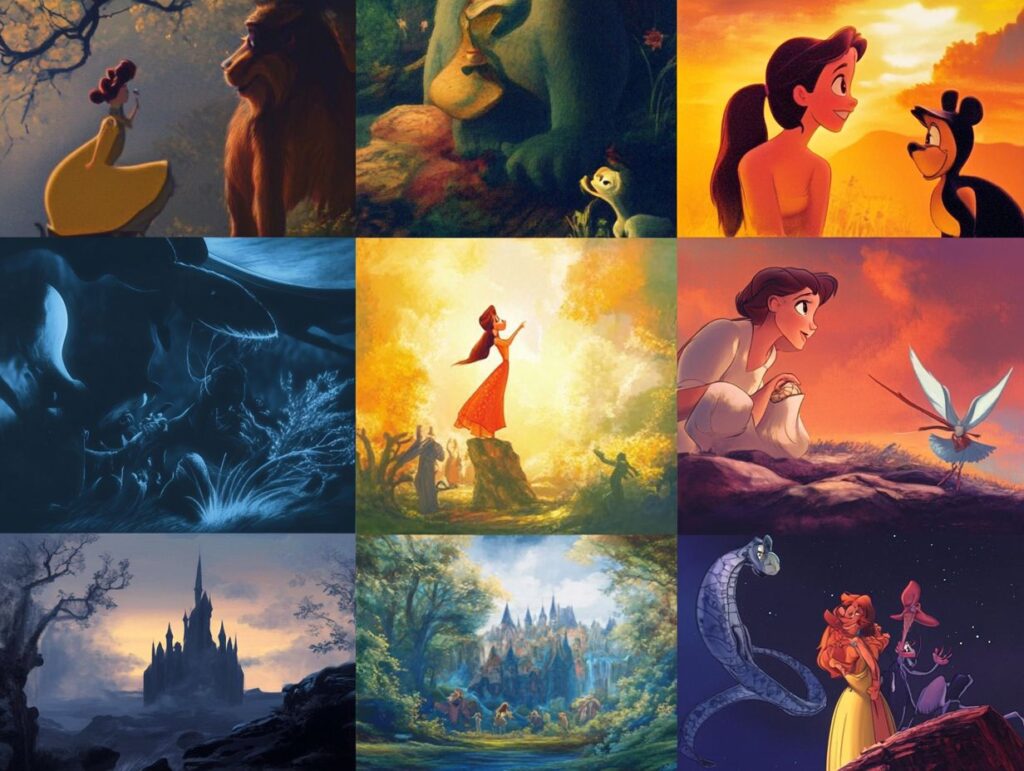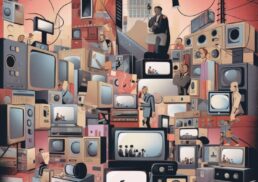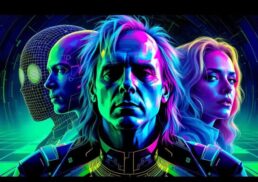Animation has significantly progressed since the era of hand-drawn sketches, evolving into a vibrant and dynamic art form that captivates audiences around the globe.
This article examines the top animated films that have not only entertained viewers but also transformed the industry. From Disney’s groundbreaking “Snow White and the Seven Dwarfs” to Pixar’s game-changing “Toy Story,” we analyze how these films pioneered new approaches in animation techniques, storytelling, and cultural impact, thereby laying the groundwork for future innovations.
We invite you to explore the evolution of animation and commemorate the milestones that have reshaped this cherished medium.
Table of Contents
The Evolution of Animation

The evolution of animation represents a compelling journey that spans over a century, characterized by significant technological advancements and artistic innovations that have transformed the animation industry into a dominant force in visual storytelling and cultural influence.
Animated films have undergone various stages of development, transitioning from hand-drawn classics such as Snow White and the Seven Dwarfs to contemporary CGI animation exemplified by esteemed franchises like Pixar and DreamWorks.
This progression highlights a profound transformation in narrative structure and audience engagement, illustrating how animation has transcended cultural boundaries while preserving its artistic integrity.
From Hand-drawn to Computer-generated
The transition from hand-drawn animation to computer-generated imagery (CGI) has significantly transformed the animation industry, providing filmmakers with the opportunity to explore new dimensions of creativity and visual appeal.
In the early days, hand-drawn animation was not only a labor-intensive art form but also a deeply valued method of storytelling, with iconic works such as The Little Mermaid representing a notable cultural milestone. This film not only revitalized Disney’s animation legacy but also resonated with audiences, becoming a cherished classic that demonstrated the potential of animation to convey profound emotional experiences.
As technology advanced, the advent of CGI introduced a new level of realism and dynamism, allowing storytellers to craft intricate worlds populated by visually captivating characters. This evolution has profoundly impacted the way narratives are constructed in contemporary animation, paving the way for a new generation of cinematic experiences that seamlessly blend imagination with cutting-edge technology.
Impact of Animated Films on the Industry
Animated films have profoundly influenced the film industry, establishing new benchmarks in storytelling, audience engagement, and artistic expression. These films have also led to the creation of successful franchises that resonate with global audiences.
From timeless classics such as *Fantasia* to contemporary successes like *Spider-Man: Into the Spider-Verse*, the impact of animated films transcends mere entertainment. They have significantly influenced popular culture and expanded the boundaries of traditional narrative structures in cinema.
How They Changed the Game
Animated films have significantly transformed the landscape of the film industry by introducing innovative storytelling and advanced animation techniques that evoke emotional resonance and enhance audience engagement.
For example, Pixar’s “Up” captivated audiences not only through its vibrant visuals but also by skillfully intertwining humor with a poignant narrative centered on loss and adventure, which resonates universally. Similarly, the remarkable visuals and intricate world-building in Studio Ghibli’s “Spirited Away” immerse viewers in a richly layered narrative that explores themes of identity and transformation, leaving a lasting impact.
Additionally, Disney’s “Frozen” has revolutionized the musical format in animation, enhancing emotional connections through powerful songs that have become cultural touchstones.
These films exemplify how animation can transcend traditional storytelling, inviting audiences to embark on complex emotional journeys through innovative techniques that extend beyond superficial engagement.
Snow White and the Seven Dwarfs (1937)

“Snow White and the Seven Dwarfs,” released in 1937, is a significant milestone in the history of animation and is widely recognized as the first full-length animated feature.
The film introduced groundbreaking animation techniques that fundamentally transformed Disney’s approach to storytelling. This iconic movie not only established a framework for future animated films but also set a standard for character dynamics, emotional depth, and narrative structure, captivating audiences and laying the groundwork for many beloved Disney classics to follow.
Revolutionizing Animation Techniques
“Snow White and the Seven Dwarfs” significantly advanced animation techniques through its innovative use of hand-drawn animation, effectively bringing to life characters imbued with emotional depth and complex dynamics that captivated audiences in an unprecedented manner.
The film utilized groundbreaking techniques such as multi-plane cameras, which introduced a remarkable sense of depth and enhanced visual storytelling by enabling characters to engage within a richly layered environment. This meticulous attention to detail allowed for nuanced expressions and movements, brilliantly reflecting each character’s personality and emotional state.
Furthermore, the harmonious integration of music and animation not only transformed character interactions but also established a deeper connection with viewers, setting a new benchmark for narrative complexity in animated films.
Consequently, Disney’s pioneering approach has profoundly influenced countless animators, reshaping industry standards and inspiring an entire generation to explore the potential of animation as a compelling narrative art form.
Toy Story (1995)
“Toy Story,” released in 1995, represented a significant milestone in the animation industry as the first full-length computer-animated film. It showcased groundbreaking techniques that established a benchmark for subsequent CGI animation.
This iconic film from Pixar not only demonstrated the technical capabilities of 3D computer animation but also engaged audiences with its compelling narrative and character dynamics, solidifying its status as a cherished classic in the realm of animated cinema.
The First Full-length Computer-animated Film
“Toy Story” is recognized as the first full-length computer-animated film, representing a groundbreaking achievement that demonstrated the evolution of CGI animation and its capacity to create compelling narratives.
Released in 1995, this innovative work not only captivated audiences with its engaging characters and heartfelt storyline but also marked a significant milestone in cinematic history. The film’s impact extended beyond mere entertainment; it transformed the animation industry by illustrating that computer-generated imagery could provide rich storytelling and emotional depth comparable to traditional hand-drawn animation.
By integrating advanced technology with a relatable narrative centered on themes of friendship and jealousy among toys, “Toy Story” established a new benchmark for animated features. The film’s success inspired other studios to explore CGI, significantly shaping the future of animation for decades and laying the groundwork for subsequent Pixar classics such as “Finding Nemo” and “The Incredibles.”
Spirited Away (2001)

“Spirited Away,” released in 2001 by Studio Ghibli, is an animated masterpiece that has significantly advanced the field of international animation by seamlessly blending traditional techniques with a compelling narrative that transcends cultural boundaries.
Directed by Hayao Miyazaki, this landmark film received widespread acclaim for its intricate storytelling, emotional depth, and distinctive artistic expression, thereby establishing itself as a cherished classic in the history of animation.
Breaking Barriers in International Animation
“Spirited Away” is widely recognized for its groundbreaking contributions to international animation, effectively showcasing the richness of Japanese culture while employing a variety of animation techniques that resonate with a global audience.
This exceptional film artfully merges traditional Japanese storytelling with whimsical visuals, crafting a narrative that engages viewers of all ages and backgrounds. The exquisite hand-drawn animation, alongside imaginative character designs and intricate world-building, allows audiences to immerse themselves in a vibrant universe where the ordinary transforms into the extraordinary.
Its reception beyond Japan was overwhelmingly favorable, earning prestigious accolades such as the Academy Award for Best Animated Feature, marking a significant milestone as the first award of its kind for a non-English language film.
By establishing a new benchmark for animation, “Spirited Away” has inspired countless creators around the world, encouraging them to explore their unique cultural narratives while employing innovative artistry to convey universal themes.
Frozen (2013)
“Frozen,” released in 2013, emerged as a cultural phenomenon and a significant box office success that transformed the landscape of animated films.
It exemplified the profound impact of emotional resonance in storytelling. As a contemporary Disney classic, the film introduced innovative animation techniques and compelling character dynamics, resonating deeply with audiences of all ages and solidifying its status within popular culture.
Box Office Success and Impact on Pop Culture
Frozen’s box office success serves as a testament to its widespread appeal and its considerable impact on pop culture, effectively redefining Disney storytelling for a new generation.
The film not only emerged as a financial powerhouse, grossing over $1.3 billion globally, but it also gave rise to an extensive range of merchandise, including dolls, apparel, and theme park attractions. This phenomenon established it as a household staple and a significant player in the retail market.
Its iconic soundtrack, particularly the Oscar-winning song “Let It Go,” catalyzed a cultural phenomenon that resonated deeply with audiences of all ages, leading to a surge in sing-along events and cover performances across various platforms.
The intricate character dynamics between sisters Anna and Elsa encapsulate themes of love, acceptance, and enablement, striking an emotional chord that has sparked meaningful conversations surrounding social movements related to identity and self-expression.
This vibrant interplay of commercial achievements and cultural significance has solidified the film’s legacy, influencing future cinematic endeavors and fostering a robust community of fans united by its enduring messages.
The Lego Movie (2014)

The Lego Movie, released in 2014, demonstrated an innovative application of animation techniques that effectively integrated CGI with live-action elements, resulting in a distinctive visual experience and broadening the horizons within the animation industry.
This film not only captivated audiences with its witty humor but also introduced groundbreaking narrative innovation that engaged viewers in a novel and dynamic manner.
Innovative Use of Animation and Live Action
The Lego Movie is widely recognized for its innovative application of animation techniques that skillfully incorporate live-action elements, resulting in a visually striking experience that expands the boundaries of traditional animated storytelling.
This distinctive combination not only engages audiences but also enriches the narrative by facilitating a dynamic interaction between the characters and their surroundings. The film utilizes stop-motion animation to replicate the appearance of authentic Lego constructions, providing each scene with a unique tactile quality that enhances character interactions.
As viewers accompany the journey of the unsuspecting protagonist, they are immersed in a vibrant universe where imagination prevails. The groundbreaking approach demonstrated in this film has established a new standard within the animation industry, motivating numerous forthcoming projects to explore similar techniques in order to craft immersive and compelling narratives.
Spider-Man: Into the Spider-Verse (2018)
Spider-Man: Into the Spider-Verse, released in 2018, is a groundbreaking animated feature that significantly advanced the standards of visual style and storytelling innovation within the animation industry.
This film captivated audiences through its distinctive combination of animation techniques, character dynamics, and a compelling narrative that resonates across cultural boundaries, establishing it as a defining moment in the realm of animated cinema.
Pushing Boundaries in Visual Style and Storytelling
“Spider-Man: Into the Spider-Verse” is widely recognized for its groundbreaking approach to visual style and narrative, utilizing a combination of diverse animation techniques to deliver a distinctive visual experience that engages audiences.
This animated feature effectively marries traditional hand-drawn artistry with advanced computer-generated imagery, producing a remarkable comic book aesthetic that captivates viewers. The implementation of dynamic frame rates and varied character designs enhances individual personalities and emotions, allowing for clear differentiation among the various iterations of Spider-Man.
Such innovation not only supports the overarching narrative but also immerses the audience in a multiverse where creativity knows no boundaries.
The rich visual language reflects the complex dynamics of the characters, facilitating a deeper connection for viewers with each hero’s journey. Ultimately, this film redefines the potential of animated storytelling.
Learn more, checkout The 30 Best Animated Movies Of All Time









